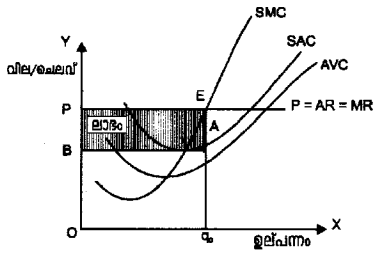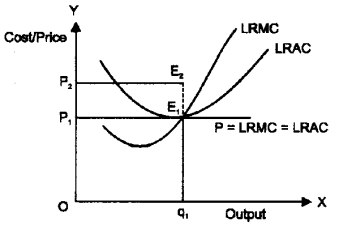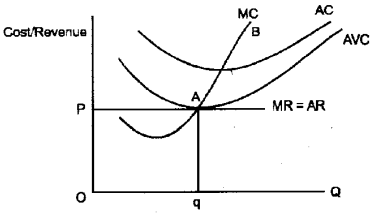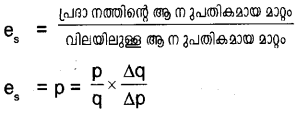Kerala Plus Two Microeconomics Notes Chapter 4 The Theory of The Firm Under Perfect Competition
Market
Market is a place where goods are bought and sold. On the basis of number of buyers and sellers, nature of the product, entry and exit, etc. markets are classified into four.
They are:
- Perfect Competition
- Monopoly
- Monopolistic competition
- Oligopoly
കമ്പോളം
സാധനങ്ങൾ വിൽക്കുവാനും വാങ്ങുവാനും ഒത്തുചേരുന്ന സ്ഥലത്തെയാണ് കമ്പോളം എന്നുവിളിക്കുന്നത്. ഉല്പന്നത്തിന്റെ സ്വഭാവം, വിൽക്കുന്നവരുടേയും വാങ്ങുന്നവരുടേയും എണ്ണം ‘കമ്പോളത്തിൽ പ്രവേശിക്കാനും പുറത്തുപോകുവാനുമുള്ള സ്വാതന്ത്ര്യം എന്നിവയുടെ അടിസ്ഥാനത്തിൽ കമ്പോളങ്ങളെ നാലായി തരംതിരിക്കാം.
- പൂർണ്ണമത്സര കമ്പോളം
- കുത്തക കമ്പോളം
- കുത്തക മത്സര കമ്പോളം
- അല്പാധീശത്വ വ്യാപാരം
Perfect Competition: Defining Features
Perfect competition is a market situation where there are large number of buyers and sellers dealing with homogeneous commodities. The perfect competitive market is rarely found in the real market situations. Some of the important features of perfect competition are listed below.
- Large number of buyers and sellers
- The firms produce homogeneous product
- Freedom of entry and exit
- Perfect mobility of factors of production
- Absence of transport cost
- Perfect knowledge about the market situations
- There would not be any interference of government in the market.
പൂർണ്ണമത്സര കമ്പോളം
ഏകജാതീയ (homogeneous) ഉല്പന്നങ്ങൾ കൈകാര്യം ചെയ്യുന്ന വളരെയധികം കേതാക്കളും വികേതാക്കളും ഉള്ള ഒരു കമ്പോള അവസ്ഥയെയാണ് പൂർണ്ണമത്സര കമ്പോളം എന്നുപറ യുന്നത്.
പ്രായോഗിക ജീവിതത്തിൽ അപൂർവമായി മാത്രം കാണുന്ന ഒരു കമ്പോള അവസ്ഥയാണ് പൂർണമത്സര കമ്പോളം. പൂർണമത്സര കമ്പോളത്തിന്റെ സവിശേഷതകൾ താഴെപറയുന്നു.
- ധാരാളം കേതാക്കളും വികേതാക്കളും ഉണ്ടായിരിക്കും.
- ഉല്പന്നങ്ങൾ ഏകജാതീയ (homogeneous)മായിരിക്കും.
- ഉല്പ്പാദന ഘടകങ്ങൾക്കും സാധനങ്ങൾക്കും പരിപൂർണ് ചലനസ്വാതന്ത്ര്യമുണ്ടായിരിക്കും.
- ഉല്പാദക യൂണിറ്റുകൾക്ക് കമ്പോളത്തിൽ എപ്പോൾ വേണ് മെങ്കിലും പ്രവേശിക്കാനും പുറത്തു പോകുവാ നുള്ള സ്വാതന്ത്ര്യം ഉണ്ടായിരിക്കും.
- ഗതാഗതച്ചെലവ് ഉണ്ടായിരിക്കുകയില്ല.
- കമ്പോളാവസ്ഥയെക്കുറിച്ച് പൂർണ്ണമായ അറിവ്
- ഗവൺമെന്റ് ഇടപെടൽ ഉണ്ടായിരിക്കില്ല.
Profit Maximisation
The main objective of the producer is to maximize the profit levels of his firm. The output level at which the firm maximizes the profit is called the equilibrium of the firm. The profit level of the firm is the difference between Total Revenue and Total Cost. Symbolically it is represented as π = TR – TC.
The fim under perfect competition maximizes its profit under three conditions. They are:
1. The MC must be equal to MR (MC = MR)
2. MC must be non-decreasing. It means that MC curve should cut the MR from below.
3. Third condition has two parts, one for short-term and the other for long-term.
a) In the short run, price should be more than or equal to the minimum point of Average Variable Cost (AVC). It can be denoted as P ≥ AVC.
b) In the long run, price should be more than or equal to the minimum point of Average Cost (AC). It can be denoted as P ≥ AC.
ലാഭം പരമാവധിയാക്കൽ
കമ്പോളത്തിൽ വിറ്റഴിക്കാനുള്ള സാധനങ്ങളും, സേവനങ്ങളും ഉല്പാദിപ്പിക്കുന്ന ഓരോ ഉല്പാദകന്റേയും പ്രധാനലക്ഷ്യം പര മാവധി ലാഭം നേടുക എന്നതാണ്. ഉല്പാദകന്റെ ലാഭം പരമാവ ധിയിലെത്തുന്നത് സ്ഥാപനത്തിന്റെ ഉല്പാദന അളവിന്റെ സന്തു ലിതാവസ്ഥയിലാണ്. ഉല്പാദന യൂണിറ്റിന്റെ ലാഭമെന്നത് മൊത്തം വരുമാനവും (TR) മൊത്തം ചെലവും (TC) തമ്മിലുള്ള വ്യത്യാ സമാണ്.
π = TR – TC
പൂർണ മത്സര കമ്പോളത്തിൽ ലാഭം പരമാവധിയാകണമെങ്കിൽ താഴെ കൊടുത്തിരിക്കുന്ന മൂന്ന് വ്യവസ്ഥകൾ പാലിക്കണം.
1. MCഉം MR ഉം തുല്യമാകണം. (MC = MR) അതായത് P = MC = MR = AR.
2. സീമാന്തചെലവ് കുറയാതെയിരിക്കണം (nondecreasing). അതായത് MC വകം MR വകത്തെ താഴെനിന്നും ഖണ്ഡി ക്കണം.
3. മൂന്നാമത്തെ വ്യവസ്ഥ
a) ഹ്രസ്വകാലയളവിൽ വില (P) ശരാശരി വിഭേദക ചെല വിന് (AVC) തുല്യമോ, കുടുതലോ ആയിരിക്കണം. അതാ യത് P ≥ VC.
b) ദീർഘകാലയളവിൽ വില (P) ശരാശരി ചെലവിന് (AC) തുല്യമോ, കൂടുതലോ ആയിരിക്കണം. അതായത് P ≥ AC.
Profit Maximization In Short-run: Diagrammatic Representation
The profit maximizing condition of a firm in short-run can be understood from the figure. All the three profit maximizing conditions of a firm in short run are satisfied at point of output level q0.
1. The price must be equal to MC (P = MC)
2. MC must be non-decreasing.
3.P ≥ AVc
Short-run profit maximization

All the profit maximizing conditions are satisfied in the figure given above.
1. The prices become equal to MC. At point E, the firm reaches equilibrium at the output level q0 (MC = MR).
2. At q0 MC is non-decreasing at point E.
3. At point E, prices have become more than AVC
(PSAVC at point E).
Therefore, three conditions for the equilibrium level of output are depicted in a single figure.
ഹ്രസ്വകാലയളവ്: ലാഭം പരമാവധിയാക്കൽ
ഹ്രസ്വകാലയളവിൽ ഒരു ഉല്പാദന യൂണിറ്റ് ലാഭം പരമാവ ധിയാക്കുന്നത് താഴെ കാണുന്ന ചിത്രം വഴി വ്യക്തമാക്കാം. q എന്ന സന്തുലിത ഉല്പന്ന അളവിൽ മൂന്ന് വ്യവസ്ഥകളും പാലി ക്കപ്പെടുന്നു.
1. വില എന്നത് MC-യ്ക്ക് തുല്യമാവണം. P = MC
2. സീമാന്തചെലവ് (MC) കുറയാതെയിരിക്കണം.
3. P ≥ AVC

മുകളിലത്തെ ചിത്രത്തിൽ മൂന്ന് വ്യവസ്ഥകളും പാലിക്കപ്പെടുന്നു.
1. വില (P), സീമാന്ത ചെലവിനോട് (MC) തുല്യമാകുന്നു. ഉല്പാ ദന നിരക്ക് q -ൽ (അതായത് MC = MR) (E എന്ന സന്തുലി താവസ്ഥയിൽ)
2. q0 ഉല്പ്പാദന അളവിൽ MC വകം മുകളിലേക്ക് നീങ്ങുന്നു. E എന്ന സന്തുലിതാവസ്ഥയിൽ)
3. വില (P) ശരാശരി വിഭേദക ചെലവിനേക്കാൾ (AVC) കുടി യിരിക്കുന്നു. അതായത് P ≥ AVC (E എന്ന സന്തുലിതാവ സ്ഥയിൽ).
Long Run Profit Maximisation
The profit maximization level of the firm is reached when the long run supply curve of the firm is that portion of LRMC curve which lies over and above the minimum point of LRAC curve (P ≥ minimum of LRAC). The supply curve of a firm in the long run is the rising portion of minimum point of LMRC. It can be explained with the help of the following figure.
ഉല്പാദക യൂണിറ്റിന്റെ ദീർഘകാല ലാഭം പരമാവധിയാക്കൽ
പൂർണ്ണ മത്സര കമ്പോളത്തിലെ ഉല്പാദന യൂണിറ്റിന്റെ ലക്ഷ്യമായ പരമാവധി ലാഭം നേടുക എന്നത് സാധ്യമാകുന്നത് വില (Q) LRAC യുടെ മിനിമത്തിന് തുല്യമോ കൂടുതലോ ആയിരിക്കുമ്പോ ഴാണ്. അതായത് P ≥ മിനിമം LRAC.
AN ദീർഘകാലയളവിൽ ഒരു ഉല്പ്പാദക യൂണിറ്റിന്റെ പ്രദാനവകം (Supply curve) എന്നത് LRAC യുടെ മിനിമം ബിന്ദുവിന് മുള്ള LRMC വകത്തിന്റെ ഉയർന്നുപോകുന്ന ഭാഗമാണ്.
Long Run Profit Maximization

Shut Down Point
When a firm produces positive level of output, the minimum output the firm should produce in order to remain in business is known as the shut down point. It is the minimum point of production for the firm to remain in the business.
അടച്ചുപൂട്ടൽ അവസ്ഥ
പൂർണ മത്സര കമ്പോളത്തിൽ ഒരു ഉല്പാദക യൂണിറ്റ് നിലനിന്ന് പോകാനുള്ള ഏറ്റവും കുറഞ്ഞ വില – ഉല്പന്ന സംയോഗത്തെ അടച്ചു പൂട്ടൽ അവസ്ഥ (shut down point) എന്നുപറയുന്നു.
Normal Profit
Normal profit is the minimum level of profit which helps the firm to remain in the business. If the firm is not earning the normal profit, it won’t be able to remain in the business. If the firm is getting less than the normal profit, the firm may continue the production in the short – run. The firm will not continue production in the long run, if the firm is getting less than the normal profit. Normal profit is covered in the cost of production. The cost of production covers rent, wages, interest and profit.
a) Supernormal profit/Abnormal profit:
The profit earned by the firm over and above the normal profit in the short run is known as super normal profit or abnormal profit. The firm will not earn any super normal profit in the long-run under perfect competition.
b) Explicit cost:
The explicit cost refers to those cost the firm incurs for the purchase or hiring of factors of production. The examples of explicit costs are on raw materials, wages and salaries of employees, etc.
c) Opportunity cost:
Every firm has some self owned factors of production. The firm does not incur any cost for using the factors of production owned by them. However, these factors of production have opportunity cost. The income that could have earned when their services are used elsewhere is known as the opportunity cost. In other words, the next best alternative that is sacrificed in the production process is known as the opportunity cost.
d) Break even point:
The point at which Total Revenue (TR) equals the Total Costs (TC) is known as the break even point. At this point, the firm gets only the normal profit. If explicit costs and opportunity costs are the part of TC, then the point at which Total Revenue (TR) equals the Total Costs (TC), then firm earns normal profit.
e) Profit maximization or loss minimization:
All three conditions for profit maximizing level of output do not guarantee that there will be profit always. The firm may make a loss based on the position of the cost curve. However the loss will be minimized at that point. So this is also known as loss minimizing level of output.
സാധാരണ ലാഭം
ഒരു ഉല്പാദക യൂണിറ്റിന് ഉല്പ്പാദനം തുടരുന്നതിന് ആവശ്യമായ ഏറ്റവും കുറഞ്ഞ ലാഭത്ത സാധാരണ ലാഭം (Normal profit) എന്നുപറയുന്നു. സാധാരണ ലാഭം ലഭിക്കുന്നില്ലെങ്കിൽ സ്ഥാപ നത്തിന് ഉല്പാദനം തുടരുവാൻ സാധ്യമല്ല. ഹ്രസ്വകാലയളവിൽ ഉല്പാദകന് സാധാരണ ലാഭത്തേക്കാൾ കുറഞ്ഞ ലാഭമാണ് ലഭി ക്കുന്നതെങ്കിലും, ഉല്പാദനം തുടർന്നുകൊണ്ടുപോകാൻ സാധി ക്കും. എന്നാൽ ദീർഘകാലയളവിൽ സാധാരണ ലാഭത്തേക്കാൾ കുറവാണ് ലഭിക്കുന്നതെങ്കിൽ ഉല്പാദനം നിർത്തേണ്ടതായി വരും. സാധാരണലാഭം ഉല്പാദനചെലവിൽ ഉൾപ്പെടുന്നു. അതാ യത് പാട്ടം, വേതനം, പലിശ, ലാഭം എന്നിവ ചേർന്നതാണ് ഉല്പാ ദന ചെലവ്.
a) അസാധാരണ ലാഭം:
ഹസ്വകാല യളവിൽ ഉല്പാദന യൂണിറ്റിന് സാധാരണ ലാഭത്തേക്കാൾ കൂടുതലായി ലഭിക്കുന്ന ലാഭത്തെ അസാ ധാരണലാഭം എന്ന് വിളിക്കുന്നു.
b)വിവക്ഷിത ചെലവ്:
ഉല്പ്പാദക യൂണിറ്റിന്, ഉല്പാദനം നടത്തുന്നതിലേക്കായി ഉല് പാദന ഘടകങ്ങൾ വാങ്ങുകയോ വാടകയ്ക്കെടുക്കുകയോ
ചെയ്യുന്നതിന് ഉണ്ടാകുന്ന ചെലവാണ് വിവക്ഷിത ചെലവ്.
c) അവസരചെലവ്:
നഷ്ടപ്പെടുത്തിയ അവസരങ്ങളിൽ ഏറ്റവും നല്ലതിന്റെ വില യെയാണ് അവസരച്ചെലവ് എന്നുപറയുന്നത്.
d) ലാഭനഷ്ടരഹിത ബിന്ദു:
ഒരു ഉല്പാദക യൂണിറ്റിന്റെ മൊത്തം വരുമാനവും മൊത്തം ചെലവും തുല്യമാകുന്ന ബിന്ദുവിനെയാണ് ലാഭനഷരഹിത ബിന്ദു എന്നുപറയുന്നത്.
e) ലാഭം പരമാവധിയാക്കൽ അഥവാ നഷ്ടം പരമാവധി കുറ യ്ക്കൽ
ലാഭം പരമാവധിയാക്കലിന്റെ എല്ലാ വ്യവസ്ഥകളും പാലി ച്ചാലും അത് ലാഭം ഉറപ്പുവരുത്തണമെന്നില്ല. ഒരു ഉല്പാ ദന യൂണിറ്റിന്റെ ലാഭവും നഷ്ടവും പ്രധാനമായും അതിന്റെ ശരാശരി ചെലവ് വക്രത്തിനെ അനുസരിച്ചായിരിക്കും. ഈ പോയിന്റിൽ ഒരു ഉല്പാദന യൂണിറ്റിന് നഷ്ടവും സംഭവി ക്കാൻ സാധ്യതയുണ്ട്. എന്നിരുന്നാലും ഈ വ്യവസ്ഥകൾ പാലിക്കപ്പെടുന്ന ഉല്പന്ന അളവിൽ നഷ്ടം പരമാവധി കുറ വായിരിക്കും. .
Supply And Market Supply
Supply means the quantity of a product that the producer is willing to sell at different prices. Market supply shows the total quantity of goods supplied by all the firms in a market at different prices.
The supply curve of a firm:
The supply curve of a firm will be that rising part of MC above the AVC.
Even though the firm makes a loss it will continue producing till it can cover the average variable cost, so that the loss could be minimized. But the firm will not produce a level of output which is greater than ‘oq’ because at this level it is not able to cover the average variable cost and will stop production at ‘oq’. This is known as the shut down point.
So shut down point is where P ≥ AVC.
The supply starts from the point A. So AB is the supply curve of a firm.

പ്രദാനവും കമ്പോള പ്രദാനവും
ഒരു നിശ്ചിത കാലയളവിൽ വിവിധ വിലയ്ക്ക് കമ്പോളത്തിൽ വിൽക്കുവാൻ നൽകപ്പെടുന്ന ഒരു സാധനത്തിന്റെ അളവാണ് പ്രദാനം.
വിവിധ വിലകൾക്ക് കമ്പോളത്തിലെ എല്ലാ ഉല്പാദകരും കൂടി പ്രദാനം ചെയ്യുന്ന ഒരു സാധനത്തിന്റെ മൊത്തം അളവിനെയാണ് കമ്പോളപദാനം എന്നുപറയുന്നത്.
ഒരു ഉല്പ്പാദന യൂണിറ്റിന്റെ പ്രദാനവകം എന്നത് അതിന്റെ AVCയ്ക്ക് മുകളിലുള്ള MC കർവിന്റെ മുകളിലേയ്ക്ക് പോകുന്ന ഭാഗമായിരിക്കും. ഒരു ഉല്പ്പാദന യൂണിറ്റ് നഷ്ടമാണ്ഉ ണ്ടാക്കുന്നതെങ്കിലും അതിന് ശരാശരി വിഭേദകച്ചെലവ് നികത്താൻ കഴിയുമെങ്കിൽ അത് ഉല്പാ ദനം നടത്താനാണ് സാധ്യത. കാരണം ആ ഉല്പ്പാദനത്തിന് നഷ് ത്തിന്റെ ആഘാതം കുറയ്ക്കാൻ സാധിക്കും. ചിത്രത്തിൽ ഉല്പാ ദന യൂണിറ്റിന്റെ വരവ് ‘op’ യ്ക്ക് താഴെയാണെങ്കിൽ അത് ഉല്പാ ദനം നിർത്താനാണ് സാധ്യത. ചിത്രത്തിൽ A എന്ന ബിന്ദു അടച്ചു പൂട്ടൽ അവസ്ഥയെ കാണിക്കുന്നു.
P ≥ AVC എന്നത് അടച്ചുപൂട്ടൽ അവസ്ഥയെ കാണിക്കുന്നു. അതായത് ഒരു ഉല്പ്പാദന യൂണിറ്റിന്റെ പ്രദാനം ആരംഭിക്കുന്നത് A എന്ന പോയന്റിൽ നിന്നുമാണ്. അതിനാൽ AB എന്നത് അതിന്റെ പ്രദാനവകത്തിനെ കാണിക്കുന്നു.
Price Elasticity Of Supply
Price elasticity of supply is defined as the degree of responsiveness of supply due to a change in price. Price elasticity of supply is normally denoted by es.
es = percentage change in supply/percentage change in price.
e = \(\frac{p}{q} \times \frac{\Delta q}{\Delta p}\)
Where; P = initial price, q = initial quantity supplied, Δq = change in quantity supplied and Δp = change in price.
If the supply curve is perpendicular to X axis, the price elasticity would be zero. If the supply curve is positively sloped (supply rises with rise in price), the elasticity of supply would be positive.
പ്രദാനത്തിന്റെ വില ഇലാസ്തികത
ഒരു സാധനത്തിന്റെ വിലയിലുണ്ടാകുന്ന മാറ്റത്തിനനുസരിച്ച് അതിന്റെ പ്രദാനത്തിലുണ്ടാകുന്ന പ്രതികരണത്തിന്റെ തോതിനെ പ്രദാനത്തിന്റെ വില ഇലാസ്തികതയെന്നു വിളിക്കുന്നു. പ്രദാന ത്തിന്റെ വില ഇലാസ്തികതയെ ‘es’ എന്നാണ് രേഖപ്പെടുത്തുക.

P = പ്രാരംഭ വില, q = പ്രദാനത്തിലെ ആരംഭ അളവ്, Δq = പ്രദാ നത്തിലെ അളവിലുള്ള മാറ്റം, Ap = വിലയിലുള്ള മാറ്റം.
പ്രദാനവകം ‘Y’ അക്ഷത്തിനു സമാന്തരമായുള്ള കുത്ത നെ യുള്ള വകമെങ്കിൽ പ്രദാനവകത്തിന്റെ ഇലാസ്തികത പൂജ്യമാ യിരിക്കും.
